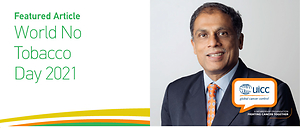As an oncologist with over 30 years of experience, it is distressing that most cancers are linked to tobacco use and therefore preventable1. These figures have remained largely unchanged over the years. Of the lung cancer cases 80–85% are attributed to tobacco smoking2. Tobacco use accounts annually for 11% of all new cases and 18% of all cancer deaths globally3. While there have been significant efforts worldwide to decrease tobacco use, a lot more needs to be done. The theme for this year’s World No Tobacco Day, ‘Commit to Quit’, draws attention to the need to help and support those addicted to quit the habit, a largely neglected yet very important measure to decrease use.
Tobacco causes 8 million deaths per year, 3 million of which are from cancer. Secondhand smoke kills over 1 million people per year, including 65000 children. There are 1.3 billion smokers globally, with 80% living in LMICs. In addition, many in the South-East Asian region use smokeless tobacco, the main cause for the high incidence of head and neck cancers in the region4. Tobacco not only affects the health of people, but also costs countries money in terms of healthcare costs and lost productivity. It has been shown that the impact of health expenditure on national economies due to tobacco related illnesses is much higher than the income revenue from the sales of tobacco products. In addition, smoking among cancer survivors remains a problem with one longitudinal study showing almost 10% of cancer survivors smoking for 9 years after their diagnosis5, illustrating the importance of developing comprehensive cessation/support programs for cancer patients who smoke.
World No Tobacco Day: ‘Commit to Quit’
Today is World No Tobacco Day, an occasion to remind the public and the international health community that tobacco remains among the most important risk factors for cancer and non-communicable diseases (NCDs).
This year, WHO has launched a full year campaign6 focusing on smoking cessation. Cessation programs are cost effective and have long-term health benefits. The campaign aims to reduce the number of tobacco users globally by empowering them to quit, using multiple tools such as ‘Florence’, WHO’s digital health worker, powered by artificial intelligence7. Cessation programs include psychological support8, and approved nicotine replacement therapies (NRT)9 that can help smokers to succeed in their efforts to quit. New products are heavily marketed10 as alternatives to smoking such as tobacco pouches, e-cigarettes and HTPs. However, we still do not know whether these products are effective in helping adults quit conventional cigarettes nor their long-term health consequences11.
From a public health perspective, multiple measures can be taken to help people quit tobacco. For instance, tobacco taxation and increases in prices have been shown to decrease smoking prevalence, making cigarettes less affordable12. Furthermore, developing smoke-free places increases the chances of successfully quitting smoking, reducing secondhand smoke exposure and has the added benefit of preventing the ‘normalization’ of tobacco use in public, which is particularly important for teenagers and children13. It is important that there is strong legislation with the enforcement of laws that ban tobacco advertising, promotion and sponsorship, as studies have shown that direct or indirect marketing approaches increase the likelihood of people continuing to use tobacco and promote public perceptions of smoking as socially acceptable14.
A multi-stakeholders’ approach
As a global cancer control organization, tobacco control is a priority area for the Union for International Cancer Control (UICC). To make real and sustained progress in reducing tobacco use, we must work across the health sector and with other sectors that are critical to tobacco control efforts including the labor, business and environment sectors. The social cost of tobacco is severe and affects several areas. We know that people deprive themselves of food in order to buy tobacco and that tobacco use is linked to poverty with people on low incomes more likely to smoke. Tobacco has a detrimental impact on the environment due to intensive farming and its impact on the water supply and because cultivating tobacco contributes to deforestation and land degradation.
We have the tools to accelerate progress in tobacco control. It is very encouraging that countries are increasingly implementing measures supporting the WHO Framework Convention for Tobacco Control (FTCT) where, in 2019, about 65% of the world’s population was covered by at least one MPOWER measure, up from only 15% in 200715. We have witnessed a decrease in smoking prevalence globally over the last decade15,16 and millions of lives have been saved from tobacco related illness and death. However, we still have much work to do to further reduce the tobacco epidemic by investing in tobacco control measures and fighting the influence of the industry. By joining forces with the tobacco control community, the cancer and NCD community, along with organizations from other sectors, can lobby governments to put strong tobacco control measures in place. We saw the result of these combined efforts recently where after strong lobbying from NGOs, Philip Morris was removed from sponsoring and participating in a major conference in Asia. We owe it to future generations to take action now to protect their health. Tobacco control must be at the heart of these efforts.


